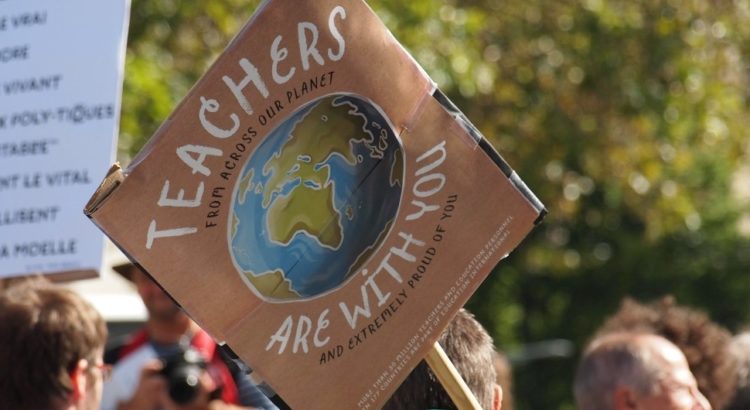Many of the headlines when the OECD releases its PISA reports focus on country rankings. While we have consistently critiqued the league table approach there is much in these reports that is useful to educators and their unions.
A good example is the PISA report for 2018[1], released in December of last year. It contains, and not for the first time, a volume on student well-being. It looks at numbers, but not only at numbers. In this report, it confirmswhat everybody knows instinctively. For example, on “school climate”, it says,
“A positive school climate is one of those things that is difficult to define and measure, but everyone – including parents – recognises it when they see it. The state of the school’s facilities, the tone of the conversations in corridors, the enthusiasm of the school staff and the way students interact during breaks are some of the signs that visitors can read to quickly and broadly assess a school’s climate.”
Teacher Enthusiasm
The PISA questionnaire for 2018 also included an attempt to measure the impact of teacher enthusiasm[2] on student well-being and achievement. Although, the link between the two areas is correlational not causal, there seemed to be a connection:
“PISA findings reveal that, in a clear majority of countries and economies, the more enthusiastic 15-year-old students perceived their teachers to be, the higher they scored in the reading assessment, even after accounting for the socio-economic profile of students and schools.”
Learning environment
The report stresses that the learning environment is not just about the school climate. There are many other factors such as the home environment, social and economic situations, andthe community. An example isbullying,which this PISA shows, as did earlier reports, is a very serious problem. It does not all take place in school, but it often “spills over” into school. As the report indicates, teachers and education support personnel play a crucial role in this domain:
“Teachers and principals not only need to be able to recognise bullying when it happens, but they may also need to create an atmosphere where bullying is less likely to occur. Research suggests that a supportive and caring school environment is linked to a lower prevalence of bullying and to students’ willingness to seek help.”
Although relationships are not a major focus of the report, it recognises that they are an essential part of school life and climate. Interestingly, and possibly related, the report shows that there is a correlation between heavy student use of the internet and feeling “sad”,
“…when students were asked how frequently they feel sad and miserable, the differences between the categories of Internet users were greater. The more time students reported spending connected to the Internet, the more likely they were to report feeling sad and miserable. For instance, on average across OECD countries, 35% of low Internet users reported feeling miserable sometimes or always, compared to 38% of average Internet users and 44% of heavy Internet users.”
The PISA report also shows the important connection between teaching and learning, positively and negatively. On the positive side, the report states,
“One of the main ideas that informs this report is that life at school is a key aspect of students’ lives. School is not only the place where children acquire knowledge but, crucially for this report, it is the place where children make friends, build trusting relationships with teachers and develop an attachment to the school.”
Teacher and Student Well-being
There is one area for which research is long overdue and that is on the link between student and teacher well-being. Both the OECD Directorate and EI agreed that this should take place but not a single OECD country has agreed to back it as a special project. PISA 2021 will include a teacher questionnaire which will also include questions for teachers on their well-being and it will then be possible to correlate evidence with student well-being. However, it is a matter of real concern that countries have not prioritised teacher well-being as worthy of research.
Conclusion
OECD has improved its policy advice significantly over the last decade. They have recognised that collective bargaining is critical to effective working relationships, have included a positive focus on teachers in their reports and are adding teacher wellbeing questions to the survey. They have recognised the importance of professional autonomy and underline the need for governments to work with teacher unions if they are going to affect positive educational change. While we will continue to challenge OECD when they apply the wrong angle, there is much to encourage in their developing approach to student knowledge.
[1] A .pdf file of Volume III can be found at https://www.oecd-ilibrary.org/docserver/acd78851-en.pdf?expires=1580739976&id=id&accname=guest&checksum=E685F984DCE02D612A363DD43D06B97B. For ease of reading, specific sources have been omitted in this article, but are available in the text and at the end of each chapter.
[2] In terms of definition, the OECD refers to what it believes to be a consensus: “Teacher enthusiasm has traditionally been defined as a lively and motivating teaching style that includes a range of behaviours, such as varied gestures, body movements, facial expressions and voice intonations, and the frequent use of humour, that reflects a strong interest in the subject. More recently, the emphasis has shifted to the pleasure that teachers take in a subject or in teaching more generally – a definition closer to the ideas of enjoyment, passion and experience.”
Fuente: https://www.worldsofeducation.org/en/woe_homepage/woe_detail/16627/%e2%80%9cpisa-well-being-and-teacher-unions%e2%80%9d-by-david-edwards








 Users Today : 103
Users Today : 103 Total Users : 35460009
Total Users : 35460009 Views Today : 148
Views Today : 148 Total views : 3418613
Total views : 3418613